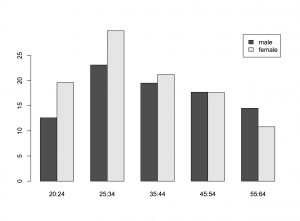Kids these days
I made this graph for a lecture on longitudinal data, then thought I’d share it. It shows the percentage of New Zealanders with post-secondary qualifications, by age and sex (data from 2006). The proportion with qualifications goes down after age 35.
Obviously NZ universities aren’t taking people’s degrees away (except occasionally), so as individual get older, their qualifications either stay the same or increase. The downward trend is a cohort effect — people born in the 1950s are less likely to end up with post-secondary qualifications than people born in the 1970s. Ten years earlier, the proportion in the 25-34 age group was 14.7% for men and 13.1% for women, so this cohort of people, now 35-44, do have more qualifications than they did ten years ago.
In this case the explanation is obvious, but often news stories talk about Kids These Days and how they should, eg, Get Off Our Lawns The Internet. After checking that the trend is real (a disturbingly important step) it’s worth asking whether the story’s attribution of the problem to age effects or cohort effects is right.
Thomas Lumley (@tslumley) is Professor of Biostatistics at the University of Auckland. His research interests include semiparametric models, survey sampling, statistical computing, foundations of statistics, and whatever methodological problems his medical collaborators come up with. He also blogs at Biased and Inefficient See all posts by Thomas Lumley »
